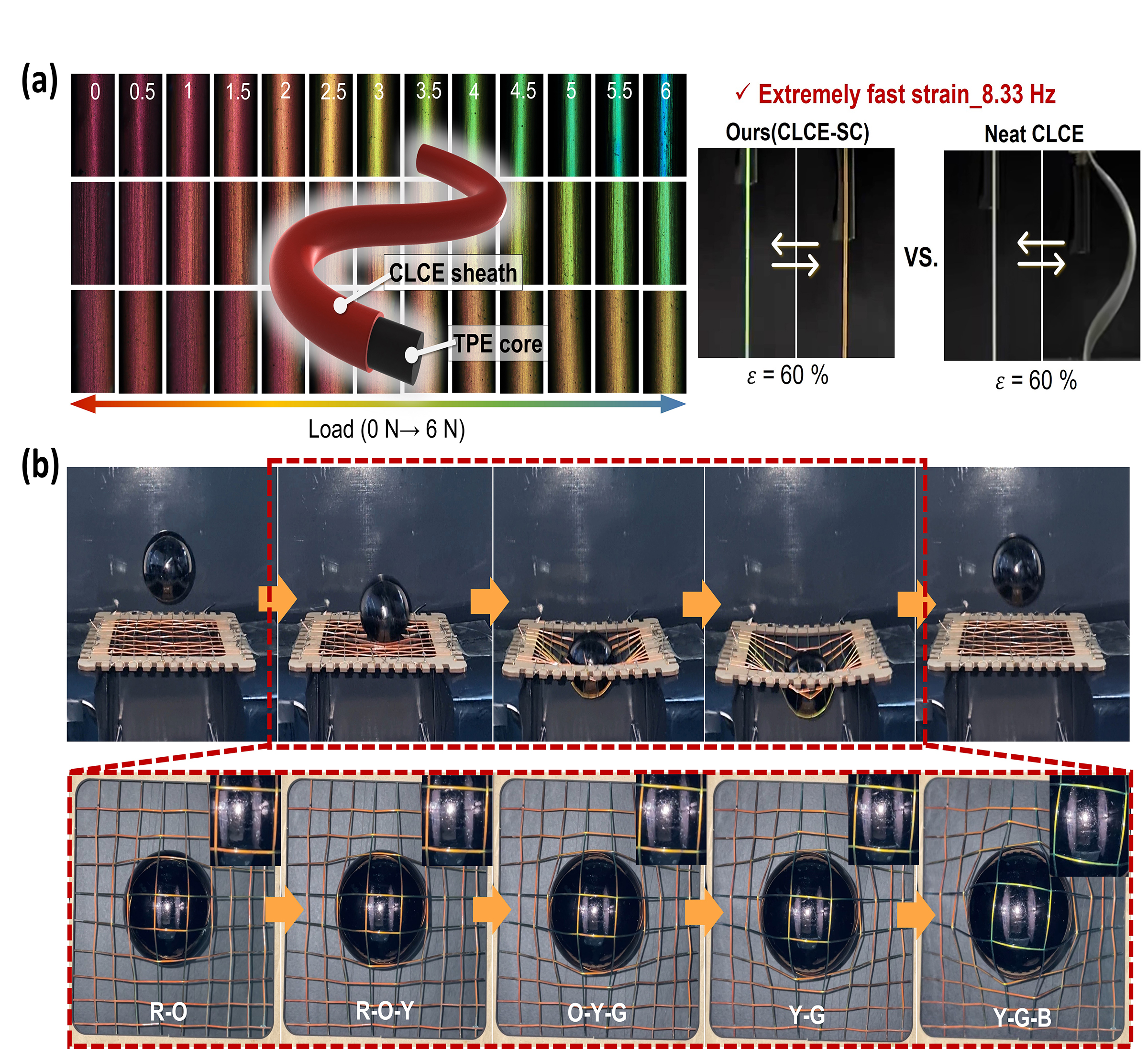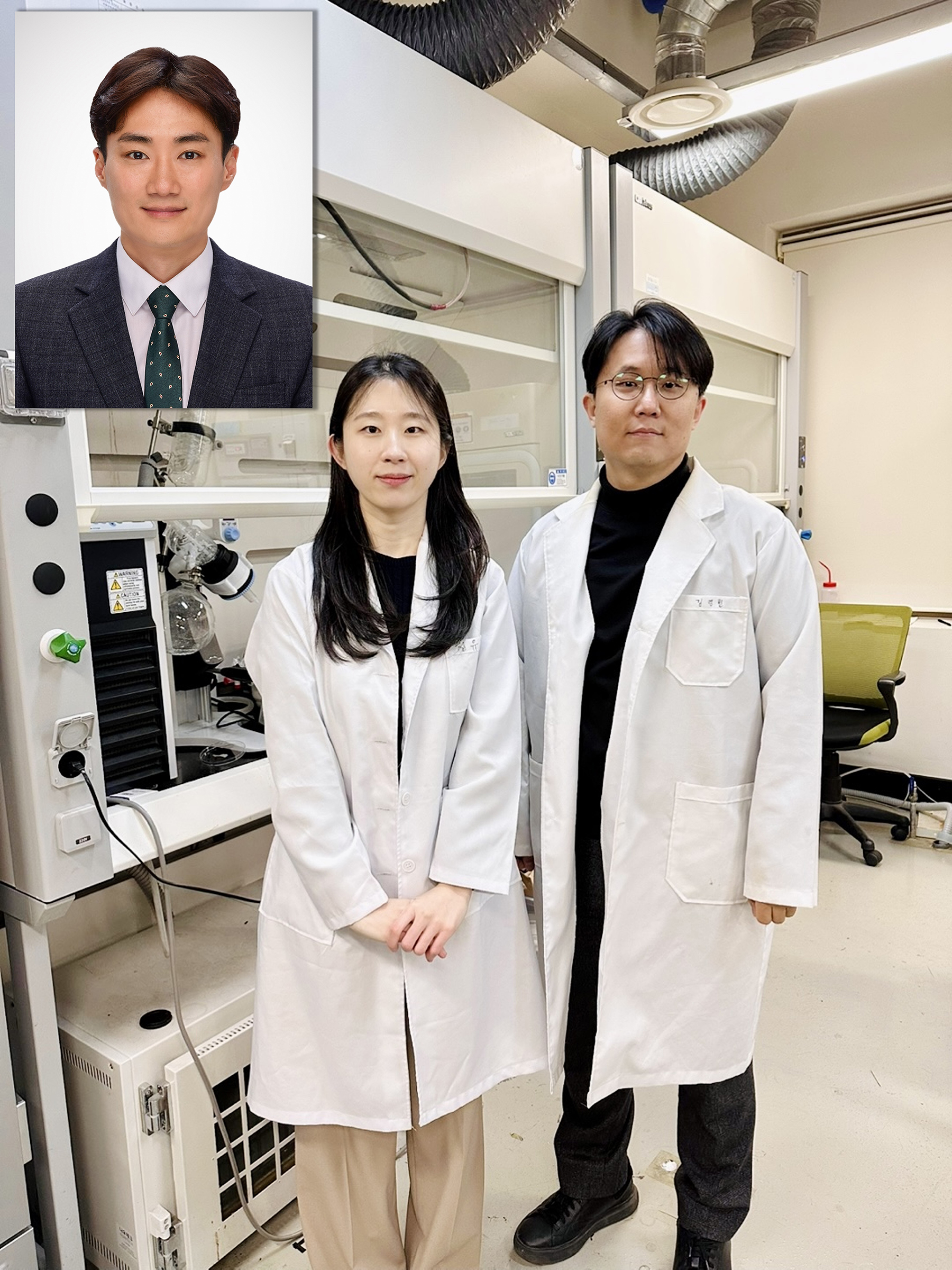커뮤니티
부경투데이
- 국립 부경대학교의 다양한 모습과 소식을 접하시면 부경대학교가 한번 더 가까워집니다.
| 부경·한양, 첨단 섬유 소재 개발 연구 '주목' (Pukyong · Hanyang, Advanced Fiber Material Development Research ‘Gains Attention’) | |||
| 작성자 | 대외홍보센터 | 작성일 | 2025-03-12 |
| 조회수 | 771 | ||
| 부경·한양, 첨단 섬유 소재 개발 연구 '주목' (Pukyong · Hanyang, Advanced Fiber Material Development Research ‘Gains Attention’) | |||||
 |
대외홍보센터 |  |
2025-03-12 |  |
771 |
국립부경대·한양대, ‘당기면 색 바뀌는’ 첨단 섬유 소재 개발
- 김대석 교수팀, 시각 센서 활용 가능한 메카노 변색 섬유 소재 실용화 앞당겨
- 네이처 자매지 <Nature Communications> 논문 게재

△ 초고속 회복성, 초강력 메카노 변색 CLCE-TPE 섬유와 직물 활용 예시 그림들.
당기면 색이 변하고 높은 회복 탄력성까지 갖춘 첨단 섬유 소재가 개발돼 주목된다.
국립부경대학교 김대석 교수(고분자공학전공)와 같은 전공 정유진 석사과정생, 한양대학교 엄영호 교수(유기나노공학과) 연구팀이 개발한 콜레스테릭 액정 엘라스토머(CLCE, Cholesteric Liquid Crystal Elastomer) 기반 메카노 변색 섬유가 그것이다.
꼬임성 나노구조가 특징인 엘라스토머 소재는 외부의 기계적인 힘에 따라 나노구조가 변하며 반사되는 색이 달라지는 메카노(기계) 변색 특성을 나타낸다. 메카노 변색은 시각적으로 즉각 인지할 수 있어 편의성이 높고, 무전력으로 반영구적 사용이 가능해 그동안 다양한 산업에서 무전력 시각 센서로 활용할 수 있는 가치를 주목받아 왔다.
특히 메카노 변색 소재 중에 CLCE는 정밀한 자기조립(self-assembly) 나노구조로 매우 선명한 색을 발현해 관심을 끌고 있지만, 강한 외력이나 고속변형에 매우 취약해 실용화에 한계가 있었다.
김대석 교수 연구팀은 이 같은 한계를 극복하기 위해 물성이 강한 열가소성 엘라스토머(TPE, Thermo Plastic Elastomer) 섬유 소재에 CLCE를 매우 정교하게 코팅하는 공정법으로 초강력-고속회복탄력성을 갖춘 CLCE 기반 메카노 변색 섬유를 개발하는 데 성공했다.
연구팀은 꼬임성 나노구조를 형성하는 CLCE의 전구체를 합성한 뒤 압력 사출로 TPE 섬유 위에 균일하게 코팅해 소재의 물성과 광학적 특성을 실용화 수준으로 끌어올렸다.
이렇게 개발한 변색 섬유는 초당 8번 반복되는 60-100% 인장 범위에서 늘어남 없이 회복되는 높은 인장-회복력을 나타냈다. 연구팀은 기존 CLCE 소재로는 힘들었던 스포츠웨어, 모빌리티, 우주항공 분야 등의 초고속 환경에서 바로 활용이 가능할 것으로 내다봤다.
또 연구팀은 TPE에 탄소나노필러를 첨가해 물성을 다양하게 조절하면 원하는 물성을 갖는 다양한 CLCE 변색 섬유를 제작할 수 있다는 연구 성과도 제시했다.
이 연구 결과를 담은 논문 ‘Ultra tough and high resilience mechanochromic fibres for real world stress detection’은 네이처 자매지인 국제학술지 <Nature Communications>에 지난 2월 게재됐다.
김대석 교수는 “이번 연구는 기존의 상용성 수준의 소재와 결합하는 복합체를 개발하는 연구를 통해 새로운 물성을 끌어내고 그 상용성을 극대화했다는 의의가 있다.”라면서, “약한 CLCE가 마치 아이언맨 슈트처럼 TPE를 장착해 강력한 힘을 내는 것처럼, 기존 특성이 훌륭하지만 물성이 약한 소재들을 중심으로 새로운 기능을 창출할 수 있는 연구를 계속해 나가겠다.”라고 밝혔다. <부경투데이>

△정유진 석사과정생(왼쪽)과 김대석 교수(오른쪽) 사진. 왼쪽 위는 한양대 엄영호 교수.
Pukyong National University and Hanyang University Develop Cutting-Edge Fabric Material that ‘Changes Color When Stretched‘
- Professor Kim Dae-seok's team accelerates the practical application of mechanochromic fabric materials usable as visual sensors
- Paper published in the Nature sister journal <Nature Communications>
A cutting-edge fabric material that changes color when stretched and possesses high recovery resilience has been developed, drawing attention.
The team, led by Professor Kim Dae-seok (Department of Polymer Engineering) from Pukyong National University, along with Master's student Jeong Yoo-jin, and Professor Eom Yeong-ho (Department of Organic Nano Engineering) from Hanyang University, developed the mechanochromic fabric based on Cholesteric Liquid Crystal Elastomer (CLCE).
The elastomer material, characterized by its twisted nanostructure, exhibits mechanochromic properties where the nanostructure changes in response to external mechanical forces, causing the reflected color to change. Mechanochromism is visually immediate, offering high convenience and the ability to be used semi-permanently without power, making it a valuable candidate for use as a power-free visual sensor across various industries.
In particular, among mechanochromic materials, CLCE has attracted attention for its ability to produce vivid colors due to its precise self-assembled nanostructures. However, it has been limited in practical applications due to its vulnerability to strong external forces or rapid deformation.
To overcome these limitations, Professor Kim Dae-seok's research team succeeded in developing a CLCE-based mechanochromic fiber with ultra-strength and high recovery elasticity by using a process that meticulously coats CLCE onto thermoplastic elastomer (TPE) fiber materials, which have strong physical properties.
The team synthesized the precursor of CLCE, which forms a twisted nanostructure, and then uniformly coated it onto TPE fibers through pressure injection, elevating the material’s physical and optical properties to a practical level.
The developed color-changing fiber exhibited high tensile-recovery strength, remaining resilient without elongation within a tensile range of 60-100% that repeats 8 times per second. The research team anticipates that this fiber, which was previously difficult to achieve with conventional CLCE materials, will be immediately applicable in high-speed environments such as sportswear, mobility, and aerospace industries.
Additionally, the research team demonstrated that by adding carbon nanofillers to TPE, they could adjust the material properties to create a variety of CLCE mechanochromic fibers with tailored properties.
This research was published in the February issue of the prestigious journal <Nature Communications>, a sister journal of Nature, under the title ‘Ultra tough and high resilience mechanochromic fibres for real world stress detection.’
Professor Kim Dae-seok commented, "This study is significant in that it maximized the commercial potential by developing a composite material that combines with existing commercially viable materials, unlocking new properties." He further emphasized, "Just as weak CLCE, like an Iron Man suit, gains powerful strength by being integrated with TPE, I will continue to conduct research focused on creating new functionalities by combining materials that have excellent properties but weak mechanical strength." <Pukyong Today>